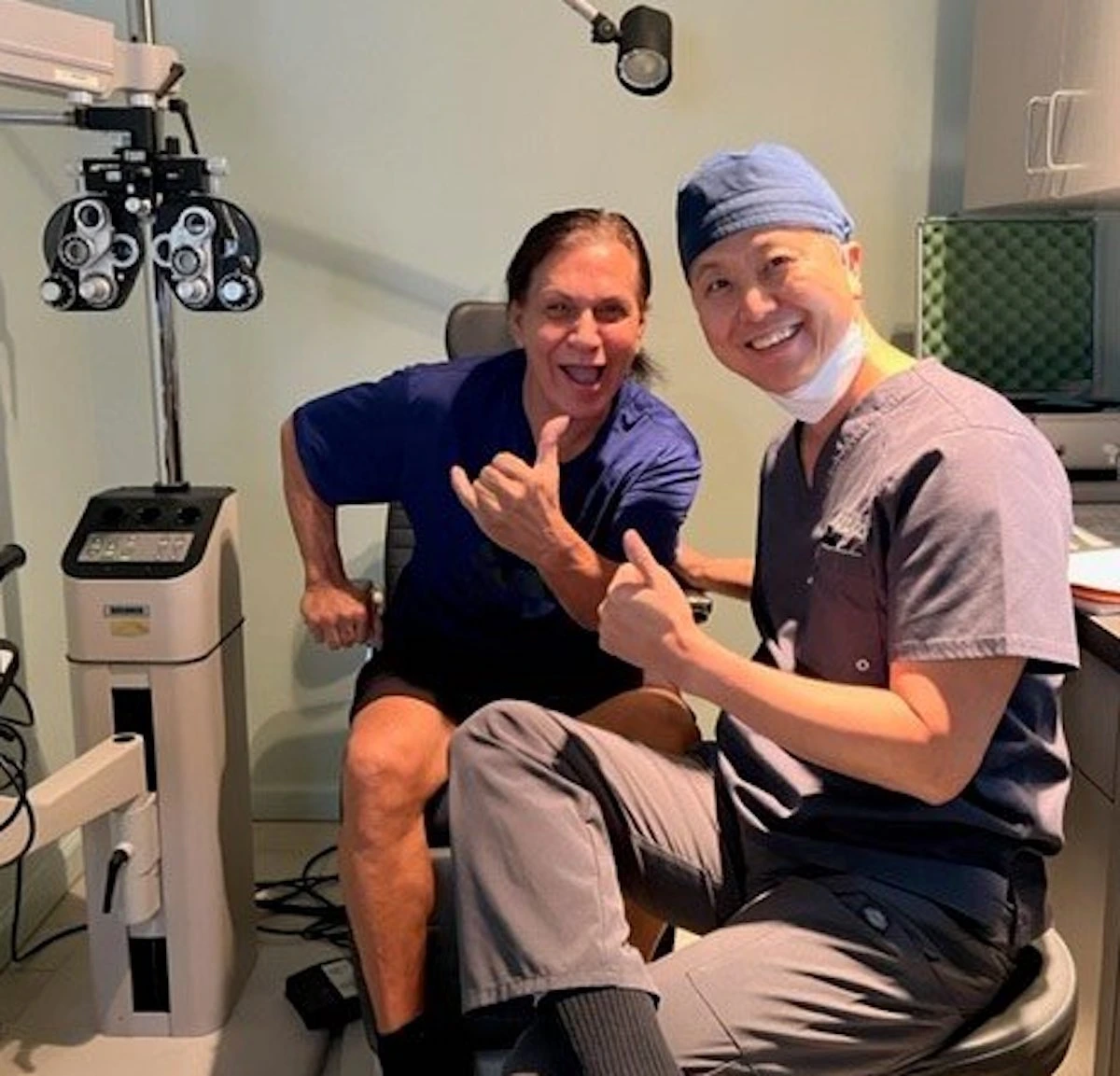Cataract Surgery
Clear Away Cataracts Today
Awarded one of America’s Best Eye Doctors by Newsweek*
*2023 Newsweek eye doctor ranking
At CCRS in Los Angeles, ophthalmologist Dr. Paul C. Lee uses the latest technology to perform fully customized cataract surgery. For our patients who want to experience their best possible vision after cataract surgery, we offer a full range of advanced intraocular lens implants (IOLs), helping them reduce or eliminate their dependence on eyeglasses or contact lenses.
- What are Cataracts?
- Symptoms of Cataracts
- Treatment for Cataracts
- Advanced Premium Cataract Surgery
- Why Choose CCRS for Cataract Surgery?
- Premium Cataract Surgery with Advanced IOLs
- Advanced Intraocular Lens (IOL) Options
- Preparing for Cataract Surgery
- The Cataract Surgery Procedure
- Recovery After Cataract Surgery
- Frequently Asked Questions About Cataract Surgery
What are Cataracts?
Cataracts develop as a part of the eye’s natural aging process. Starting in the mid-40s, the proteins that make up the lens of the eye begin to build up and clump together, causing the lens to become cloudy. These cloudy areas are called cataracts. Cataracts make it more difficult for light to pass through the lens onto the retina, causing a person’s vision to become increasingly dim and blurry.
According to the National Eye Institute (NEI), roughly
Trusted Source
Cataract Data and Statistics
National Eye Institute
Go to Source
50%
of Americans will develop cataracts by the time they are 75 years old. However, newer diagnostic devices such as iTrace show a significant reduction in the quality of vision starting at an earlier age. Dysfunctional Lens Index (DLI) measures the visual quality of a patient’s
Trusted Source
Characterization of Dysfunctional Lens Index and Opacity Grade in a Healthy Population
Martínez-Plaza E, Ruiz-Fortes P, Soto-Negro R, Hernández-Rodríguez CJ, Molina-Martín A, Arias-Puente A, Piñero DP
Go to Source
lens.
People often compensate for the gradual deterioration in vision by increasing the light brightness and adapting to less clarity. Following cataract surgery, patients often notice that “the sky has become bluer and the roses redder.”

Brightening worlds for over 20 years.

Symptoms of Cataracts
When cataracts are in their early stages, symptoms are mild and may not even be noticeable. However, as the eye’s lens grows more cloudy, patients will begin to notice vision problems.
Trusted Source
Cataracts
Cleveland Clinic
Go to Source
Symptoms
of cataracts include:
- Cloudy vision
- Blurry vision
- A faded or yellowed appearance to colors
- Light sensitivity
- Halos and glare at night
- Difficulty driving at night
- Double vision
- Requiring a bright light to read
- Increasingly frequent changes in corrective lens prescription

Treatment for Cataracts
At first, patients may be able to achieve tolerable vision correction by updating their prescription for glasses or contact lenses. Over time, clouding from cataracts will present significant vision problems that impact a patient’s daily activities such as reading and driving. When this happens, the only treatment for cataracts is cataract surgery, during which the cloudy lens of the eye is removed and replaced with an artificial intraocular lens (IOL).
Advanced Premium Cataract Surgery
At every stage of the cataract surgery process, Dr. Lee relies on state-of-the-art technology, allowing him to achieve ultimate accuracy and precision and optimizing our patients’ outcomes.
In preparation for the cataract surgery, Dr. Lee uses advanced technology diagnostic devices such as iTrace, Pentacam corneal analyzer, and Argos swept-source biometer. These devices give highly precise information about different components of the eye’s focusing mechanism. Furthermore, through utilization of artificial intelligence and ray tracing technology, Dr. Lee can develop a customized surgical plan and demonstrate an anticipated post-surgical vision for the
Trusted Source
IOL Formulas: USing AI to Improve Accuracy
American Academy of Ophthalmology
Go to Source
patients.
A key component of customization is the selection of the most suitable premium IOL for each patient to meet their visual needs. Dr. Lee has expertise in all premium IOLs for an optimal outcome.
Modern advanced cataract surgery usually takes about 15 minutes and is performed as an outpatient procedure. Dr. Lee utilizes a cutting-edge ultrasound phacoemulsification device called Centurion with Active Fluidics to break up the cataract and remove it through a very small incision, approximately 2.5 mm. The procedure usually involves minimal discomfort and is done under local
Trusted Source
Facilitating Phaco with Cutting-edge Tech
Kent, Christopher
Go to Source
anesthesia.
Additional intraoperative measurement is made using a device called ORA SYSTEM with VerifEye+ Technology™. This state-of-the-art technology uses wavefront aberrometry to assess the eye’s refractive power after removing the cataract to yield aphakic refraction. This data helps Dr. Lee to select IOL with correct spherical and astigmatism power for optimal surgical
Trusted Source
Evaluation of Refractive Accuracy of ORA and the Factors Impacting Residual Astigmatism in Patients Implanted with Trifocal IOLs During Cataract Surgery: A Retrospective Observational Study
Watanabe K
Go to Source
outcomes.
Why Choose CCRS for Cataract Surgery?
At CCRS, your eye health and the clarity of your vision is our highest priority. Board-Certified Ophthalmologist Dr. Paul C. Lee has earned a reputation for precision, meticulousness, and the highest quality of patient care. In addition to this, CCRS employs the most state-of-the-art technology for cataract surgery, including iTrace and ORA with VerifEye™ leading to optimal vision correction for our patients. Dr. Lee performs advanced cataract surgery in the comfort of his in-office surgery suite, which means our patients enjoy a more convenient and comfortable experience while under our care.


I had Dr. Lee perform cataract surgery on my left eye a couple weeks ago and [am] very happy with my procedure... I would highly recommend Dr. Lee. He is definitely a world-class physician that I'm very grateful I found. My vision was really bad before the surgery. I'm amazed what a difference it made.
Tony
Premium Cataract Surgery with Advanced IOLs
Cataract surgery involves replacing the cloudy lens of the eye with an intraocular lens (IOL). In the past, only standard, monofocal lenses were available to cataract surgery patients. These lenses are covered by insurance, and can improve near or distance vision but not both. Also, standard IOL does not correct astigmatism. This means that patients may still need to wear corrective eyewear such as reading glasses after cataract surgery.
For patients who want to achieve independence from glasses or contacts, Dr. Lee offers premium cataract surgery with advanced IOLs. These lenses give patients the ability to customize their vision correction, improving refractive errors such as nearsightedness (myopia), farsightedness (hyperopia), astigmatism, and presbyopia (age-related near vision loss). After premium cataract surgery with advanced IOLs, many of our patients are able to reduce or eliminate their need for corrective lenses.
Advanced Intraocular Lens (IOL) Options
All patients experience clearer vision once the blurry lens of their eye is replaced during cataract surgery. However, by selecting from one of these advanced IOL options, our patients are able to customize their cataract surgery results for even better vision correction outcomes.
Presbyopia-Correcting IOLs
With age, the lens of the eye becomes more rigid, making it more difficult to focus on near objects. This age-related near vision loss is called presbyopia, and begins to affect everyone starting in their 40s. We offer a number of IOLs that can help reduce or even eliminate patients’ reliance on reading glasses. Dr. Lee is an expert in all forms of presbyopia-correcting IOLS that include, trifocal, extended depth of focus (EDOF), and Small Aperture (Apthera IC-8) IOLs.
Astigmatism-Correcting IOLs
Toric IOLs are designed specifically for patients with astigmatism, which may impact both near and distance vision. Our patients have access to toric IOLs that correct vision at a single distance as well as toric IOLs that can correct vision at multiple ranges.
Light Adjustable Lens
Designed by a Nobel Prize-winning scientist, the Light Adjustable Lens allows Dr. Lee to adjust the power of the lens after its implantation. Through a series of office-based light treatments that take only a few minutes, Dr. Lee can customize vision to fit the lifestyle needs of his patients.

Preparing for Cataract Surgery
The first step to achieving clearer vision after cataract surgery is to attend a consultation with Dr. Lee. Following an eye exam, Dr. Lee will explain the cataract surgery procedure to you and you will learn more about the IOL options available to you. You will be able to discuss your vision concerns and goals, and together you and Dr. Lee will decide on the best cataract surgery treatment plan for your unique needs and lifestyle.
Once your surgery is scheduled, you will receive detailed pre- and postoperative instructions.
The Cataract Surgery Procedure
Cataract removal surgery is an outpatient procedure performed on one eye at a time and takes only about 15 minutes.
Before the procedure begins, anesthetic eye drops will be administered to numb your eye. You will also be given an oral sedative to help you relax, and a device will be used to hold your eye open so you won’t need to worry about blinking.
To begin the cataract surgery procedure, Dr. Lee will make a small incision in the cornea at the front of the eye. The cloudy lens will be broken up and removed in a process called phacoemulsification, then the new intraocular lens implant will be placed. The incisions used for cataract surgery are so small that no sutures are necessary: the eye will naturally heal itself.
Recovery After Cataract Surgery
After cataract surgery, you will be fitted with an eye shield to help protect your eye during the healing process. You will only need to wear this shield briefly, but it is important to keep it on while sleeping.
It is normal to experience mild irritation and/or soreness following cataract surgery, but this will resolve quickly. Most patients are able to get back to work and most activities the following day. Dr. Lee will ask that you avoid more strenuous activities for at least two weeks.
Frequently Asked Questions About Cataract Surgery
No. Your eyes will be numbed during the cataract surgery procedure. You may feel some pressure, but most people do not experience significant pain.
Cataract surgery is one of the most frequently performed surgical procedures in the world, and is also considered to be one of the safest. The American Academy of Ophthalmology states that
Trusted Source
Cataract Surgery: Risks, Recovery, Costs
American Academy of Ophthalmology
Go to Source
risks
of cataract surgery, while rare, may include inflammation, infection, suboptimal vision correction, and retinal detachment.
You will be able to get back to most of our normal activities the day after your cataract surgery. To ensure that your eyes heal properly, Dr. Lee will ask you to refrain from certain activities, such as strenuous exercise or swimming, for two weeks.
The cost of cataract surgery is dependent on each patient’s insurance plan, unique treatment plan and the types of IOLs used. Dr. Lee will give you a detailed cost breakdown for your cataract surgery during your consultation.
When a person’s cataracts have progressed to the point where their vision is significantly impaired, cataract surgery with a standard intraocular lens is covered by insurance. Patients do pay out-of-pocket for advanced IOLs and special tests, but most of our patients feel that these investments in their vision are well worthwhile. Our team will be happy to help you learn more about payment and financing options for cataract surgery.
Yes, you can get cataract surgery after LASIK. However, the planning for the cataract surgery, namely choosing the power of the lens to be used, becomes more complex. For this reason, it is a good idea to keep a record of your LASIK surgery. Pre-LASIK information can be helpful in planning for cataract surgery. However, now with Light Adjustable Lens (LAL), Dr. Lee can fine-tune post-surgical vision to a patient’s liking, thus optimizing vision and reducing the need for glasses.
No. Once the cloudy lens of the eye is replaced with a new lens, cataracts will not come back. Some patients may have heard of a condition called secondary cataracts, which is actually a condition called posterior capsule opacification (PCO). This is different from cataracts, and can be treated with an in-office procedure called YAG capsulotomy.
Contact Us
To learn more about your cataract surgery options, please contact us to schedule a consultation at our Los Angeles or Sherman Oaks ophthalmology practice.
1 National Eye Institute. Cataract Data and Statistics. Available: https://www.nei.nih.gov/learn-about-eye-health/resources-for-health-educators/eye-health-data-and-statistics/cataract-data-and-statistics. Accessed April 24, 2023.
2 Martínez-Plaza E, Ruiz-Fortes P, Soto-Negro R, Hernández-Rodríguez CJ, Molina-Martín A, Arias-Puente A, Piñero DP. Characterization of Dysfunctional Lens Index and Opacity Grade in a Healthy Population. Diagnostics (Basel). 2022 May 7;12(5):1167. doi: 10.3390/diagnostics12051167. PMID: 35626322; PMCID: PMC9140515. Available: https://pubmed.ncbi.nlm.nih.gov/35626322/. Accessed June 21, 2023.
3 Cleveland Clinic. Cataracts. Available: https://my.clevelandclinic.org/health/diseases/8589-cataracts. Accessed April 24, 2023.
4 American Academy of Ophthalmology. IOL Formulas: USing AI to Improve Accuracy. Available: https://www.aao.org/eyenet/article/iol-formulas-using-ai-to-improve-accuracy. Accessed June 21, 2023.
5 Kent, Christopher. Facilitating Phaco with Cutting-edge Tech. Review of Ophthalmology. Published December 10, 2021. Available: https://www.reviewofophthalmology.com/article/facilitating-phaco-with-cuttingedge-tech. Accessed June 21, 2023.
6 Watanabe K. Evaluation of Refractive Accuracy of ORA and the Factors Impacting Residual Astigmatism in Patients Implanted with Trifocal IOLs During Cataract Surgery: A Retrospective Observational Study. Clin Ophthalmol. 2022 Aug 10;16:2491-2503. doi: 10.2147/OPTH.S371555. PMID: 35974901; PMCID: PMC9375987. Available: https://www.ncbi.nlm.nih.gov/pmc/articles/PMC9375987/. Accessed June 21, 2023.
7American Academy of Ophthalmology. Cataract Surgery: Risks, Recovery, Costs. Available: https://www.aao.org/eye-health/diseases/what-is-cataract-surgery#recovery. Accessed April 24, 2023.
The doctors at CCRS have reviewed and approved this content.

